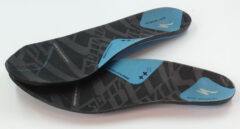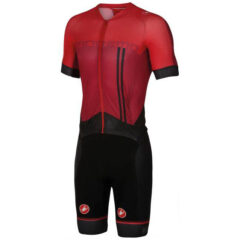Many people experience foot pain after several long days of cycling. Issues with foot comfort may not be apparent or may be very minor during typical training rides, but can become extreme during longer races. Bikepackers do everything in one pair of shoes, so pedal style (road vs MTB) is important.

Page Contents:
Shoes
Many people find that their feet grow slightly when riding for many hours on multiple days, so it’s very important to have a pair of shoes that fit well and are not likely to feel cramped in the toe area even if your feet start to swell. There have been multiple stories of people cutting out sections of their shoes during a race to relieve pain induced by shoe tightness. On the other hand, shoes should not be too loose around the heel to prevent blisters from developing due to friction.
Higher-end models of shoes often come in half sizes and sometimes different widths to get the fit just right. Some higher-end shoes can also be heat-molded to your foot. Higher-end models also normally have a more elaborate method of closure, which may allow a better fit to be achieved. I especially like how the tightness can be easily fine-tuned when using a Boa lacing system even while riding. Despite these advantages of higher-end shoes, many people can find a very comfortable pair of mid-priced shoes.
The stiffness of the shoe’s sole is also an important aspect of comfort. I’ve tried super-stiff racing shoes from a few manufacturers and despite the comfort being fine and the stiffness and weight being great for rides of up to about 6-8 hours, I haven’t found any that give me sufficient comfort for ultra-distance rides. For ultracycling, I actually prefer mid-price, less race-oriented shoes. However, other people are lucky and have found a high-performance shoe that is comfortable enough for any length of ride.
Whether you use road or MTB-style pedals probably won’t make much difference to comfort or power on the bike if the shoes are a reasonable quality and fit well. When off the bike, MTB-style shoes allow you to walk almost normally whereas road-style shoes make walking more difficult and awkward and require spare cleats, cleat covers, or other shoes to be carried. In my opinion, the only reason for using a road-style pedal and shoe system for a bikepacking race or any long-distance cycling is if you have a pair of road shoes that are extremely comfortable and you cannot find something as comfortable in a MTB-style shoe.
Some MTB shoes are heavily reinforced, chunky, and heavy, but there are models that are quite similar to road shoes apart from the tread on the sole and the cleat holes. If MTB shoes are delivered with removable toe spikes for running in mud then they should be removed.
Some people experience “hot-foot” or feel uncomfortable pressure-points under the ball of their feet, particularly if they are using MTB-style pedals and shoes. They often blame this on the smaller size of a MTB cleat, but this is only true if the shoe’s sole is not stiff enough, which is often the case with entry-level MTB shoes and most shoes that are marketed as “touring” shoes (which are OK for walking around a church, but not good for pedaling long distances). This is easy to avoid by using mid-range or upper-end MTB shoes that have sufficient stiffness – how large the cleat is under the sole then won’t make any difference.
Insoles

Insoles help to support the arch of the foot and so ease some of the stress on the foot muscles. Some shoes come with moldable insoles and aftermarket cycling insoles are available in a variety of arch heights (e.g., Specialized Body Geometry SL Footbeds). In addition, angled shims exist that fit under the toes between the insole and shoe (e.g., Specialized) that can help to correct ankle, knee, and hip alignment problems.
If foot pain develops, it may help to concentrate on pedaling in smooth, complete, round circles. This spreads the energy around the pedal cycle rather than just pushing during the downstroke. Adopting such a pedaling style hasn’t been proven to increase performance or efficiency, but if it reduces foot pain then it’s worth trying.
Spare Parts
Shoe and cleat problems can be as serious as bike problems, so you should be prepared to do simple repairs. Most shoes have mechanical closure systems (ratchets or Boas), so I recommend bringing spare parts for those when doing a race plus any special tools needed. Cleat bolts can come loose and get lost, so carry one or two spare bolts. People who use road-style shoes often carry one or two spare cleats during a long race because they may wear them out before the finish due to walking on them (these won’t be needed if using MTB-style shoes).
Cleat Position & Foot Comfort
A few long distance cyclists find it more comfortable to have their cleats much further back on their shoes than is traditionally recommended, but most people position their cleats under the ball of their foot. If you feel a hot spot directly on top of your cleat then changing the position of your cleats or using more supportive insoles may help. Mark your shoes to show exactly where you want your cleats to be in case they move and you need to reposition them.
The angle of the cleats is more related to knee comfort than foot comfort. It should be set so that pedaling feels natural without any tendency for the knee to push inwards or outwards. Some knee issues can be resolved by rotating the pedal cleat to remove any twist in the leg.
Here is a GCN that explains how to setup your cleat angle and position. They use a road shoe for the demonstration, but the technique is the same for a MTB shoe:
Some people can only avoid knee issues by using a pedal that allows their foot to freely rotate, in which case Speedplay pedals (either the road or MTB version) are regarded as the best option, but I can’t see advantage of those pedals if you don’t have any knee problems. A few people are only comfortable using regular, flat pedal that don’t fix their foot at all. They can still benefit from using cycling-specific shoes with stiff soles, so MTB-style shoes with bolt-on covers over the cleat holes are a decent option (Shimano SM-SH30, SJS Cycles).
Pedal Recommendations
Based on my experience working in a bike shop, Shimano pedals are far less likely to develop problems with the bearings than most of the other brands. The single-sided versions of Shimano’s SPD pedals, the ES600 (Amazon), look slightly sleeker but I prefer the added convenience of the double-sided versions for bikepacking and would choose the M540 (Amazon) to save some money or the M8100 (Amazon) to save weight (functionally, they are virtually the same). The “Trail” version of Shimano’s MTB pedals (e.g., the M8120: Amazon) have a surrounding cage which is useful on technical terrain when there is not enough time to click in, but offers no advantage for road use in my experience.
If you do choose to use road pedals and shoes then the Shimano 105 road pedals (R7000 model, Amazon) are excellent value. Look is the main competitor to Shimano in road pedals, but Look pedals are notorious for developing play in the bearings very quickly and the bearings cannot be serviced like they can in a Shimano pedal. The special design of Speedplay pedals (Amazon) means that they have a very low-profile pedal body that only has space for very small bearings, which need to be re-greased regularly.
Last significant page update: November, 2016
This page is in the Rider Comfort section. The next page in this section is:

